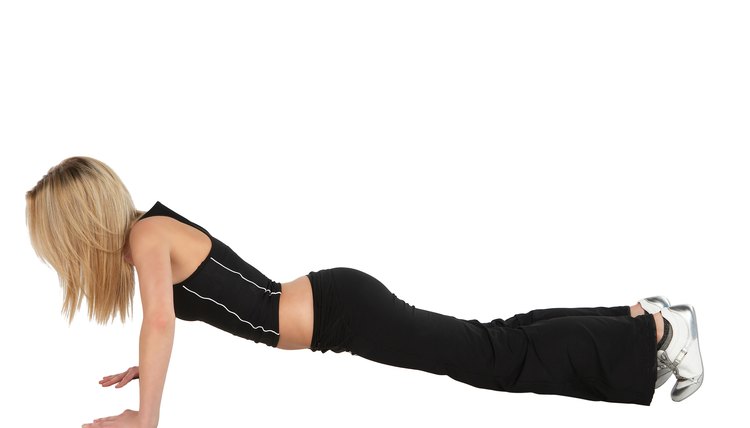What Muscles Are Used in Pushup Exercises?

The pushup is an effective movement that targets the chest, shoulders and arm muscles. You can do several variations of the traditional pushup. These exercises include the incline pushups and the decline pushups. By performing the exercise at different angles, you will recruit the main muscles to a larger, or lesser, degree.
Chest
The main muscle group worked during the pushup is the pectoralis major of the chest. This muscle group comprises two heads: clavicular head and sternal head. The former is also known as the upper chest, the latter as the lower chest. When you do a traditional pushup with your torso parallel to the ground, you primarily target the lower chest, and the upper chest serves as an assisting mover. When you do the exercise at an incline angle, the lower chest is also the primary muscle worked, with the upper chest serving as a secondary mover. In the third main pushup variation, the declined angled pushup, you primarily target the upper chest, and the lower chest acts as an assisting mover.
Shoulders
During each of the pushup variations, the anterior deltoid of the front shoulders acts as a secondary mover. It is common to feel a burn in this muscle while doing the pushup, and this is because of the buildup of hydrogen ions that come off of lactic acid. To minimize this burning sensation, you should keep your repetitions below 15.
Arms
There are four other muscles, all located in the arm region, that act as secondary movers during the pushup and its variations. Three of these muscles are collectively known as the triceps brachii. Those muscles are the triceps long head, lateral head and medial head. The remaining arm muscle worked is the anconeus.
Stabilizers
In addition to the primary and secondary movers, the pushup involves several stabilizing muscles that help fixate the joints at work. The biceps brachii of the arms acts as a stabilizer of the elbow joint. The serratus anterior, rotator cuff muscles and rhomboids stabilize the scapula. The rectus abdominis and obliques of the waist, along with the erector spinae of the spine all act as stabilizers of the spine. The quadriceps of the front thigh acts as a knee stabilizer and the gluteus maximus acts as a hip stabilizer.
Tips
If you are a beginner, the pushup may be difficult for you to perform, so you may want to have a spotter on hand to assist you with the movement. Over time, as you become more comfortable with the movement of the pushup and develop sufficient strength, you can then do the exercise on your own. You may even want to add resistance to further stimulate the muscles being worked.
References
Writer Bio
Richard Choueiri is a fitness and nutrition expert and the author of "The Human Statue Workout." He began writing professionally in 2007 and his work has been featured in Bodybuilding.com and "Physique Magazine." Choueiri studied exercise science and nutritional science at Rutgers University. He holds an American College of Sports Medicine CPT, and a National Exercise and Sports Trainers Association CMMACC.
